When I adopted my pibble furball, I noticed she didn’t respond to commands very well. She worked with a professional trainer while in her foster home but at 3 years old, she’s dealt with many different caretakers and she basically decided she didn’t want to obey anymore. Her princess-state-of-mind said she’s had enough.
I’ve trained a lot of dogs over the years, but this pup was a challenge. I had to find a method of training that sparked her attention. Something she hadn’t encountered yet. After a lot of research and speaking with professional dog trainers, I decided clicker training might be my best shot.
I’ve never attempted clicker training, so I had some learning to do myself. It was going to be an adventure!
What is dog clicker training?
Clicker training, according to Karen Pryor clicker Training,
“Is an animal training method based on behavioral psychology that relies on marking desirable behavior and rewarding it.”
The desirable behavior is marked by the “Click” from a small, mechanical, hand-held device. The dog performs a behavior, hears the click, and receives a reward. Eventually, the dog associates that combination of events with a reward.
Dogs are food motivated. They love getting rewards for pleasing us. They just don’t always know how to please us. That’s why we train them!
Clickers are an easy way to signal to our dog that she’s done something to please us. She will learn to continue that behavior to receive a reward.
Years ago, I trained a German Shepherd to sit and shake his Paw for a treat. Well, he took that trick to the next level. He would randomly sit down in front of me and hold his paw in the air in hopes he would get a treat. Such a smart boy! I loved his enthusiasm.

What is a clicker? Why is it different?
A clicker is…
A hand-held mechanical device that makes a short, distinct “Click” sound. This sound signals to the dog that she’s done something right.
A clicker is different because…
It is a clear form of communication to the dog. Instead of words that change (meaning sometimes we praise with “Good girl!” and other times we praise with “Yes!”) and might confuse the dog, the clicking sound never changes. Additionally, the click is a sound that a dog does not hear in other circumstances. The strange noise gets their attention.
This form of communication combined with positive reinforcement (a treat!) is an effective, safe, and humane method of teaching a dog which behavior is desirable.
Why use a clicker instead of food lure training?
Dogs are extremely food-motivated. Offer them a treat and they’ll do almost anything. But that behavior could get out of hand if you’re not careful.
Eating handfuls of treats every day can be like you eating 4 bacon cheeseburgers every day. Depending on the treats you use they can be high in fat and calories.
Using cooked chicken, turkey, baby carrots, or kibble is a healthier option. But using a clicker is sometimes the best way to reward your dog for good behavior.
This can be a struggle for some dogs – like my Greta – who is extremely food-motivated and won’t learn a command unless there’s a treat being offered. However, I use a clicker and a treat on occasion to remind her that food is still a possibility. She won’t eat too much but I still keep her attention.
Can you use clicker training at any age?
Yes! The only obstacle you may hit with clicker training an older dog is the ability to hear the Click. Just like humans, dogs’ ability to hear weakens with age. That distinct click may become quiet or inaudible. Otherwise, any pup can learn clicker training!
What are the benefits of clicker training?
- Clicker training is a highly rewarding method of training. This encourages your dog to try new things with the promise of a treat.
- Reward-based training sessions can last longer than non-reward-based sessions, which means you can teach your dog more and build her motivation to learn more.
- You can practice several repetitions of the same behavior without losing your dog’s interest in the activity.
- The clicking sound perfectly marks which behavior is being rewarded which makes your dog learn quicker.
- Being a positive training session, you will build a stronger bond with your dog.
- As a trainer and handler, your training methods will improve by increasing the positivity in your sessions.
- Your dog will focus on you more with a clicker because she is actively thinking about what behavior she performed that rewarded her with a click and a treat.
- You will build your dog’s confidence by teaching her how to be a well-behaved and rewarded dog.
- The sound of the clicker is unique to your dog. She doesn’t hear that distinct noise in other environments. Whereas, she hears your voice all the time. This means she is more likely to pay attention to the click sound as opposed to your voice giving commands.
What do I need to start clicker training my dog?
- Clicker
- Pouch of treats
- Yummy treats (cooked chicken or turkey, pieces of carrot, or kibble are healthy options)
- Your fur-baby
It’s that simple!
What does it mean to “charge a clicker”?
No, it doesn’t mean you plug the clicker into an outlet and charge the battery. The phrase just means you reinforce your dog’s association with the click and getting a treat.
If you never give a treat after a click, your dog won’t show interest in the click. If you charge the clicker, your dog will remember that Click = Reward.
To keep the association strong, it’s best to provide a treat within 3 seconds of the click. Too much time in between and your dog might forget why she’s getting the treat.
How to clicker train your dog?
Getting started:
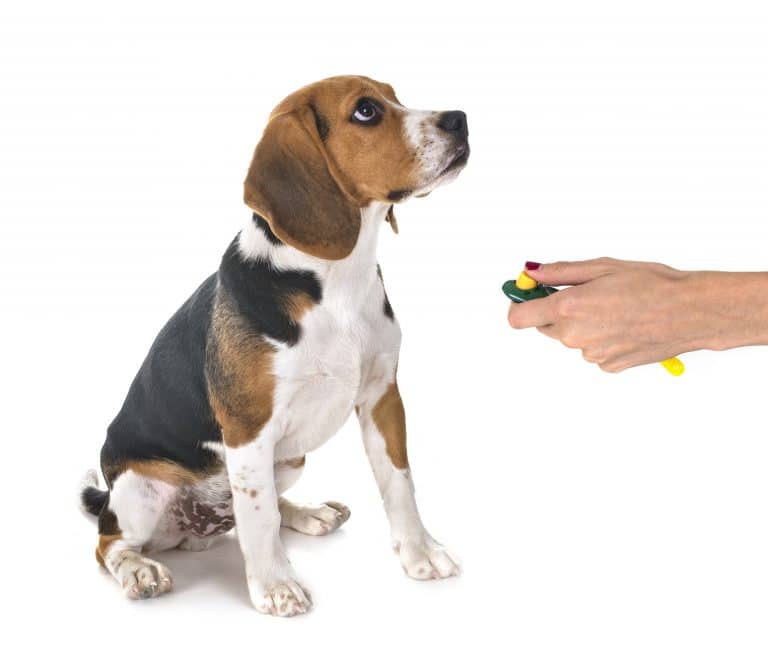
Learn how to use the clicker.
They’re readily available at almost any pet store for about $5. It’s a small, handheld plastic device with a button or metal tongue that your press to make the clicking noise.
- The key to using the clicker is making the noise at the exact moment that your dog performs the desired behavior.
- The sound of the click should always be followed immediately by a treat or other reward.
- The clicker is a signal that a reward is coming, rather than being the reward itself.
- Think of the clicker as a buzzer on a game show signaling that you just won the grand prize, but for your dog.
Introduce your dog to the clicker.
Before using the clicker in a training session, teach your dog that the clicker means a treat is coming. This is the “charging the clicker” that we talked about earlier.
Go to a quiet room and hold a treat in one hand while holding the clicker in the other hand. Depress the clicker one time. When your dog looks at your because she heard the sound, give her a treat. You’re teaching her that paying attention to you because of the noise is a good thing.
- You’ll probably need a handful of treats.
- Repeat the click-treat, click-treat, click-treat as many times as needed until your dog understands the concept of responding to the clicker.
- If your dog attempts to sniff at your hands and get a treat before the click, keep your hand closed and hide your hand in a pocket so she loses interest in searching.
Monitor your dog’s responses to the clicker.
Some dogs may find the sound interesting. Other dogs may be sensitive and run away from the sound. If so, you can wrap your hand in a towel to soften the clicking sound.
Alternatively, you could use a ballpoint pen as a training clicker. It’s still a distinct clicking noise but it’s less harsh.
Alas, if your dog is still sensitive to that noise, you may need to stick with verbal commands and cues in training.
Training your dog with a clicker
Choose a quiet room or other location with no distractions.
By now your dog should know what to expect when she hears the clicker sound. Now you can use it to train her to do different commands or tricks!
- Sit, down, stay, shake hands, etc.
- Or more complicated tricks like roll over, fetch, or seek.
- Once your dog is comfortable with clicker training, you can hold sessions in areas with distractions like a TV, people, or other animals.
Click when your dog is in the act of the desired behavior.
This will teach her that her current actions will be rewarded. “Catching” is one method of clicker training where you click as soon as you catch your dog performing a behavior on her own.
For example, if you catch your dog lying down to get comfy, click and toss her a treat. After she gets up to eat the treat and lies down again, click again and throw another treat. Repeat the process.
- The “catching” method only works when your dog already knows how to do the behavior, like lying down. It may not work so well for rolling over or fetching.
- Clicker training will reinforce in your dog’s mind that she’s doing something right, which will encourage her to repeat that desired behavior.
Use the clicker at each small step of the new behavior.
This is called “shaping.” You’re shaping the new behavior into a whole act. For example, if you’re teaching your dog to roll over, you want to click as she sits, when she lays down, as she begins to roll on her side, and as she rolls over her back to her other side.
- By using the clicker and rewarding each step, you are providing her with continued positive reinforcement as she grasps the new behavior.
- Practicing each step may take some time before you can move on to the next step.
Use food as a lure.
If you’re teaching your dog to lie down, have them sit and hold the treat in front of their nose but don’t give it to her. Slowly move the treat straight down towards the floor. Ideally, your dog will lie down as she follows the treat. Once her back end and elbows are both touching the floor, click and give her the treat.
My Greta was a stubborn one with his command. She would follow the treat, put her elbows on the floor, but stick her butt in the air. Ugh.
- When your dog consistently responds to the food lure, remove the lure but still hold your hand in front of her nose. She’ll think you still have a treat. When she lies down (or performs the behavior) use the clicker and give a treat.
- Eventually, your dog will learn the behavior by following only your hand signals without a lure.
- The “lure” method is often quicker than the “shaping” or “catching” methods.
Use hand signals.
Even if you’ve trained your dog to respond without a lure, continue to use hand signals to help her understand what you want her to do.
- Point to the ground or move your hand downward if you want her to lie down.
- Hold your hand out in front of your dog with your open palm facing up if you want her to shake her Paw.
Use verbal cues to accompany all hand signals.
Verbal cues help your dog understand what you want her to do. Say the cue, then give the hand signal, and then wait for her to perform the behavior you asked. As soon as she does, click and give her a treat.
- Keep verbal cues short. One word. Two at most. Sit. Down. Stay. Phrases or sentences are too long and your dog won’t understand them. “Be a good girl and lay down” is far too long.
- Be sure to give the verbal cue before your dog performs the behavior so she knows to listen for the cue before responding.
- Again, if you’re using the lure method, give the hand signal after the verbal cue, then wait for her to perform the behavior before clicking and treating.
Teaching your dog to “Sit” with a clicker
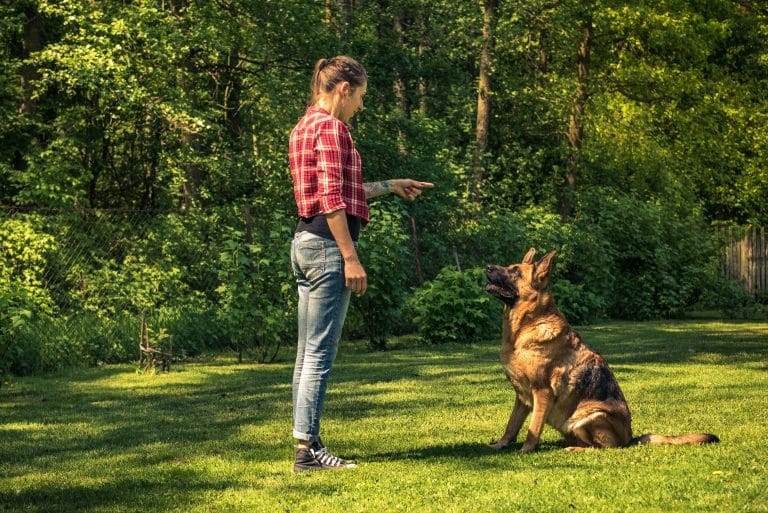
You have a couple options for teaching your dog to sit on command with a clicker.
“Sit” by capturing
If your dog often sits on her own, the capture method can be highly effective. With clicker and treats in hand, wait until you catch her sitting by her own free will. Click and give her a treat. Let her walk around and wait for her to sit again.
Add the verbal cue after she consistently sits about 90% of the time. The moment before her hindquarters touch the ground as she’s sitting, say “sit.” After a few repetitions of this, only click after she sits when you’ve asked her to.
“Sit” By Luring
If your dog isn’t self-motivated but highly food-motivated, luring may be the best method. Start with your dog standing in from of you.
Hold a treat in your hand in front of her nose. Move your hand up and over her head so that she has to move her head backwards. Naturally, her hind end should lower into a sitting position to accommodate following the treat. Dogs can’t look up without sitting down in the process because of their bone structure. Use this to your advantage!
Watch for the moment when her hind end touches the floor and click, then give her the treat. Repeat the process a few times, then try it without holding the treat. Once she has that down, add the verbal cue right before her back end touches the ground. Then only click and treat when she sits after you’ve asked.
If your dog tends to back up to follow the treat instead of sitting, position her in a corner so she can’t back up.
How to teach a dog to play fetch using a clicker ?
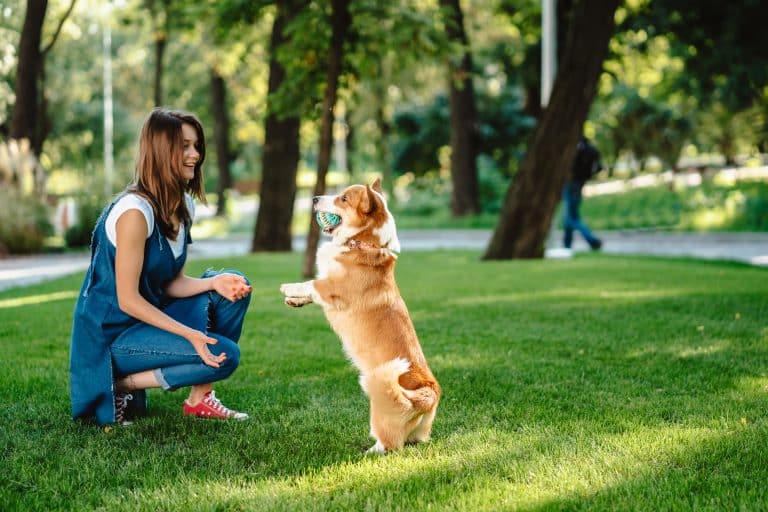
Most dogs love playing fetch. It’s in their nature to chase and retrieve.
- Start by finding one of their favorite toys.
- Play with the toy for a few moments to get your dog excited about it.
- Toss the toy a few feet away from you. If your dog moves toward it, click and treat. If he doesn’t move toward the toy, pick it up and shake it around to get his attention. When he moves toward it (while you’re holding it), click and treat.
- Repeat the toss-click-treat step until your dog consistently moves toward the toy. Then toss the toy a little further away. Repeat the click-treat when she moves towards it.
- Eventually, stop clicking and treating when she moves towards the toy. Only click and treat when she makes contact with the toy. Then stop clicking and treating unless she picks up the toy.
- Continue working in this manner until you have the dog retrieving the toy and bringing it to you. An excited, high-pitched voice is often encouraging.
- Return to step 3 and re-engage if your dog loses interest at any point.
Tips and rules for successful clicker training
- Always give the treat within 3 seconds of clicking.
- Click for the desired action. Click for each step until the entire action or position is complete.
- 1 click = 1 treat.
- Training sessions should be no more than 30 minutes per day. Less if your dog gets frustrated.
- When you start each training session, start a step or two back from where you ended the previous session.
- If teaching fetch with a clicker, don’t throw the toy so high that your dog would have to jump up to catch it. Knee injuries are common when dogs leap and land in this manner.
- Use soft toys such as plush or rubber that won’t damage teeth, gums, or the mouth. Sticks can puncture the tongue, throat, neck, or chest.
- Clicker training is not command-based so do not order her around. If she doesn’t perform the desired act, she isn’t disobeying, she just doesn’t understand yet.
- Carry a clicker at all times if you’re “capture” training.
- The clicker does not cue your dog to do something so you can’t use like a remote control.
Timing is key when clicker training a dog
Training sessions may go smoother when your dog is hungry so keep track of when she’s eaten. If you’re using the lure method, an empty stomach will motivate her to obey more to get more treats.
Use small, soft treats with moisture. Cooked chicken or turkey is often a favorite, I’ve found. You can use dry treats or kibble, but it may dry out your dog’s mouth and cause her to pay more attention to getting a drink of water instead of learning new commands.
Clicker training troubleshooting
If you introduced clicker training properly but your dog doesn’t respond to the clicker, you may need to elevate your enthusiasm.
“My dog doesn’t respond to new cues right away.”Stay patient and keep trying. Some behaviors are challenging and take time.
“My dog hears the click but doesn’t seem interested in repeating the action.”Make sure you’re using food as a lure.
“My dog doesn’t look for a treat until I’ve clicked 3 or 4 times.”Stop clicking so much. Only click once. Dogs can count, so if you click 3 or 4 times to get her to look for the treat, she’ll learn to count the clicks and respond accordingly. Click-treat. Click-treat. Click-treat. That’s the key.
“My dog isn’t interested in food lures.”Don’t feed your dog before a training session. Practice in the afternoon. She’ll be hungry and looking for tasty treats to fill her tummy.
“My dog doesn’t respond to hand cues.”Define them more clearly. For example, simply lowering your hand to the ground will not teach your dog to lay down. Use a treat and have her nose follow your hand to the ground. Then remove the treat. She’ll get the connection.
Clicker training mistakes to avoid
- Using multiple clicks for 1 treat.
- Waiting too long between clicks and treats.
- Clicking after your dog has performed the desired behavior.
- Waiting to click for the final behavior when you’ve only begun with a new cue.
- Attempting to teach a hand signal without a lure.
- Getting impatient when your dog doesn’t perform a behavior while using the “capture” method.
Dogo App
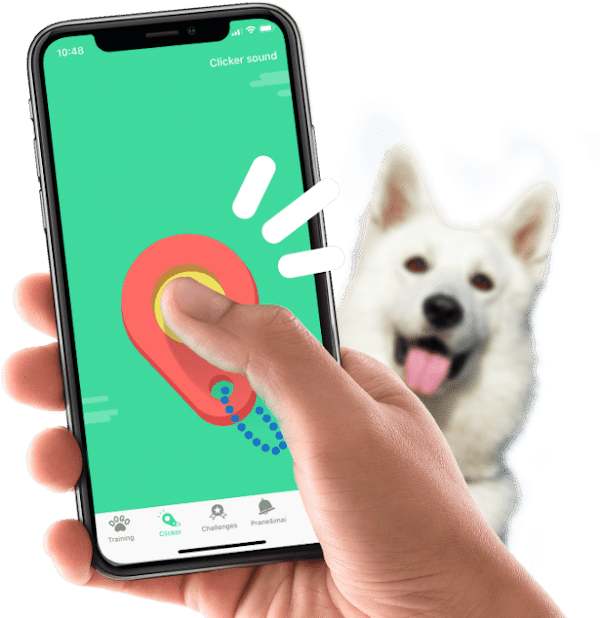
Get tips on basic obedience, potty training, how to improve your puppy’s naughty behavior or teach an adult dog fun tricks without leaving home. Become best friends with your dog through positive reinforcement training with a built-in clicker.
iClicker – the free dog training app
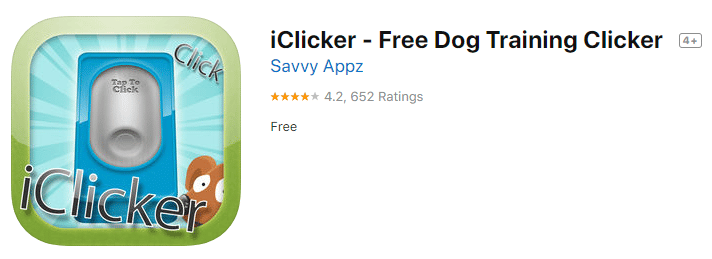
iClicker is a free app where you press a “button” on your phone screen and it makes the distinct click sound. It’s free and convenient in the app store for iOS users!
The app provides tutorials on charging the clicker, what treats to use, and teaching commands such as sit and stay. The app also includes YouTube videos like “The 1st Thing to Teach Your Dog” and “What to Avoid Training at First.”
You can also use the “Noise Box” for practice with distractions and desensitization. Noises include dog toys, duck calls, squeaks, meows, roars, and barking dogs.
Summary
Clicker training is a simple and effective method of teaching your dog to perform desired behaviors. It involves positive reinforcement that encourages your dog to do what you want for the reward of a treat.
Are you using the clicker training method for your pup? What have you taught her so far? We would love to hear your story!
Have you found this blog post valuable? Please let us know in the comments!
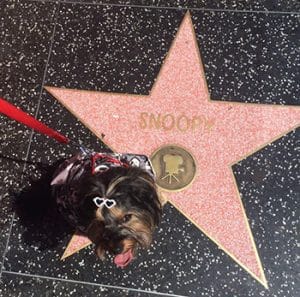
One Request From Speedy
Kelly Siedhof put so much effort writing this blog post to provide value to the dog parent community. It’ll be very helpful for me, if you consider sharing it on social media networks.
SHARING IS ♥️


